2011 UN
12th Annual CTAUN Conference
January 14, 2011 – United Nations, NY
“ACHIEVING THE MILLENNIUM DEVELOPMENT GOALS:
TEACHING FOR ACTION”
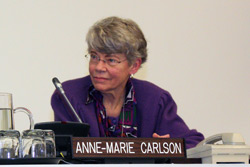 Anne-Marie Carlson, chair of the Committee on Teaching About the United Nations (CTAUN), opened the conference by welcoming the 403 registrants from the US, Canada and Sweden, including a group of 48 from The Delta Kappa Gamma Society International and 23 from the American Association of University Women, as well as 15 Fulbright scholars from 14 countries. She went on to review the program for the day and introduced our morning keynote speaker.
Anne-Marie Carlson, chair of the Committee on Teaching About the United Nations (CTAUN), opened the conference by welcoming the 403 registrants from the US, Canada and Sweden, including a group of 48 from The Delta Kappa Gamma Society International and 23 from the American Association of University Women, as well as 15 Fulbright scholars from 14 countries. She went on to review the program for the day and introduced our morning keynote speaker.
MORNING KEYNOTE:
NICHOLAS KRISTOF
Pulitzer Prize winner, NY Times
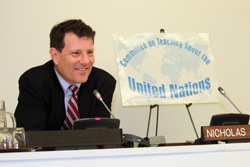 Mr. Kristof began with a tribute to young people, who, feeling increasingly empowered by empowering others, are becoming more engaged in social justice issues and committed to making a difference.
Mr. Kristof began with a tribute to young people, who, feeling increasingly empowered by empowering others, are becoming more engaged in social justice issues and committed to making a difference.
He quoted a Chinese proverb, “Women Hold Up Half the Sky,” which became the basis of the book, HALF THE SKY, that he co-wrote with his wife, Sheryl Wu Dunn. He went on to say that there are two main themes to the book, which he then illustrated anecdotally. The first is that, just as slavery in the 19th Century and totalitarianism in the 20th were the primary moral issues of their day, so in the 21st Century is oppression of and injustice to women.
In the 1990s, in the Hubei province of China, he said, there were a great many female dropouts from school due to the fact that 19% of parents were unwilling to invest in girls’ education, which could be had for a mere $13.00 a year. He told of a girl named Dai ManJu, whose story appeared on the front page of the NY Times, and who, along with many others, did receive an education thanks to a mistaken $10,000 donation, which the bank, with “encouragement” from Mr. Kristof, agreed to pay. Dai ManJu was the first in her province to graduate from high school, and subsequently became an accountant, enriching her family, as did others in the village who benefited from the gift.
He pointed out that there are more men in the world than women, and showed a photo of a feeding center in Ethiopia, where, when resources are limited, the policy is to “feed the sons and starve the daughters”. There is a 1 in 5 risk of death in Ethiopia, and the mortality rate is 50% higher in women. Between 60 and 100 million women are missing around the world, more than all the genocides of the 20th Century.
Human trafficking is modern slavery. Girls are typically kidnapped at age 13, either sold by their parents or given the ruse of a potential job. He showed a photo of one girl in Cambodia whose eye was gouged out because she was ‘uncooperative’. To remove them from such an environment, Mr. Kristof purchased the freedom of two girls, for which, appalled, he received receipts for $150 and $200.
The second theme of his book is that women are not the problem, but the solution to issues of global poverty and insecurity, and that the key to reducing the birth rate is the education of women. In Niger 1 in 7 women dies in childbirth. For every one who dies, 20 others are injured, many by fistulas, which are internal injuries caused by improper delivery methods, and which, because of their external manifestations, (incontinence etc.) cause such women to become pariahs in their society while still in their teens. Yet the determination of the human spirit and instinct for survival makes for heart-wrenching stories. He told of one Ethiopian woman, who, left in a hut without a door, so that the hyenas could get at her, managed to sleep in a tree, and though unable to walk, crawled 30 miles to an American mission to receive surgery to remove her fistula; she is now working as a nurse in a hospital in Addis Ababa.
He spoke about the difficulties of micro-finance in India and Bangladesh where it began with Nobel Peace Prize Winner Mohammed Yunus, and which, despite a good deal of success, (e.g. a woman named Sima Mahomet in Lahore, Pakistan, who was skilled in embroidery, ended up hiring 30 workers, including her own husband) is now under fire for degenerating into ‘get rich quick’ schemes by some bankers. Lenders failed to give women support in the workings of micro credit, causing suicides among women who couldn’t pay back their loans. In addition, banks in South Asia charge 40% interest on deposits. Nonetheless, ‘low technology’, which is prevalent in developing countries, makes it possible to store and password protect credit on cell phones.
He spoke about the challenges to girls’ education which make concentration difficult: lack of nutrition, worms, anemia, safety issues imposed by the need to travel long distances and the lack of separate facilities for girls. Many miss school due to menstruation. Yet solutions exist: 1 pill for de-worming, which lasts a year, and costs 50 cents, can reduce absenteeism by 25%, and in Ghana, a program to provide sanitary pads cuts absenteeism by half. There is also a shortage of teachers – who get paid even if they are absent from school, so the motivation to regular attendance is sometimes lacking.
He addressed doubts about program effectiveness. Does aid work? Many aid groups stress only the need, turning potential donors away. There is a misconception about people in places like sub-Saharan Africa – that poverty has always existed there, and no matter how much money is invested, poverty and hunger will never be eliminated. Yet, though not perfect, the track record is good. In 1960, 20 million children died before the age of 5. Now, due to the use of vaccines and bed nets, the eradication of smallpox, and the near eradication of guinea worm, the number has been reduced to 8 million. Despite the fact that survival has not been attainable for everyone, for each individual who is saved, the impact is transformative.
“Why should I Care?” Engagement in a cause greater than oneself is what brings happiness and new perspectives to those who give. When you put a face to suffering, it becomes real. He ended by encouraging us to get out into the developing world and see for ourselves.
Overview of the MDGs
DR. GONZALO PIZARRO
Policy Specialist, United Nations Development Programme (UNDP) –– www.undp.org
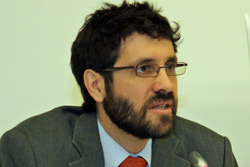 Dr. Pizarro’s goal was to give a brief history of the Millennium Development Goals, and to correct some of the misconceptions surrounding them.
Dr. Pizarro’s goal was to give a brief history of the Millennium Development Goals, and to correct some of the misconceptions surrounding them.
In 2000, a gathering of heads of state of 189 countries at the United Nations, created a framework to give structure to projects that had been ongoing in the field for many years. Recognizing the need to look at issues holistically, rather than individually, and the need for numerical targets by specific deadline dates, the MDGs were given their current form. By 2015 all member states pledged to:
- Eradicate extreme poverty and hunger, reducing by half the number of people living on less than a dollar a day
- Achieve universal primary education
- Promote gender equality and empower women, eliminating gender disparity in primary and secondary education
- Reduce by two-thirds the mortality rate among children under five
- Improve maternal health, reducing by three-quarters, the maternal mortality ratio
- Combat HIV Aids, malaria and other diseases, halting and beginning to reverse their spread
- Ensure environmental sustainability, integrating the principles of sustainable development into country policies and programmes, reversing the loss of environmental resources, reducing by half the proportion of people without safe drinking water, and achieving significant improvement in the lives of at least 100 million slum dwellers by 2020
- Develop a global partnership for development by the target date of 2015: This includes developing further an open trading and financial system that is rule–based, predictable and non-discriminatory; commitment to good governance; addressing the special needs of the least developed countries, including tariff and quota-free access for
their exports, enhanced debt relief and more generous official assistance for countries committed to poverty reduction; addressing the special needs of landlocked and small island states, developing decent and productive work for youth, access to affordable essential drugs and making available the benefits of information and communications
technologies.
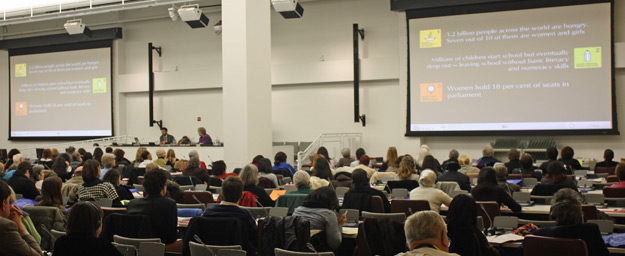
He asked us to guess the amount of foreign aid the US dispenses each year. In a poll taken in 2006, many Americans thought the US spent 25% of its gross domestic product on overseas aid, and voted to reduce it to 10%. The reality is that the US spends less than 1%. In the Monterrey Agreement of 2002, developed nations committed themselves to .7%.
He gave us some statistics: in 2000, 1.2 billion people in the world were hungry; 7 out of 10 were women and girls; women held only 8% of positions of power; 536, 000 women died in childbirth. A decade or so later, change is on track, but uneven geographically, with greater progress in countries like China and Viet Nam, and less in Latin America and sub-Saharan Africa. “Foreign aid should be consistent,” he said, and challenged us to find the area that most resonates with us personally and volunteer, donate, pressure Congress and empower students and people abroad.
MORNING PANEL:
Poverty, Hunger and Environmental Sustainability – MDGs 1, 7 and 8
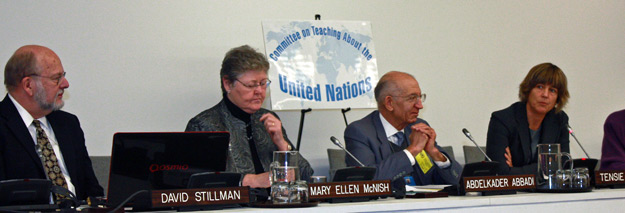 Moderator: Dr. Abdelkader Abbadi, UN correspondent –The Independent
Moderator: Dr. Abdelkader Abbadi, UN correspondent –The Independent
Speakers: Mary Ellen McNish, President and CEO, The Hunger Project — www.thp.org
Dr. David Stillman, Executive Director, Public-Private Alliance Foundation — www.ppafoundation.org
Tensie Whelan, President, Rainforest Alliance — www.rainforest-alliance.org
MS. MCNISH
– began by saying that business as usual will not end world hunger. She then addressed the myth that shipping food will end hunger. She added the startling fact that not only will it not help, it will actually hurt, as most of the hungry are food farmers, and most farmers are women with no voice in decision making. Food aid would only compete with what they produce.
Her solutions: Mobilize for self-reliance, provide workshops to empower women, form committees around the MDGs led by women, and partner with local governments, as most problems can only be solved at the local level. She spoke of vibrant rural communities with no limits on what could be accomplished if they were enabled. The Hunger Project works in 8 countries in Africa, as well as India, Bangladesh, Mexico and Peru.
DR. STILLMAN
– began by saying that while barbecues may be a treat for us, they are no picnic for the world’s poor. The World Health Organization (WHO) found that noxious fumes from charcoal impacted negatively on women and children, and that 9 million worldwide die of exposure to cookstove smoke. He spoke of the Global Alliance for Clean Cookstoves, established in Sept. 2010, and housed in the UN Foundation.
He also spoke about the connections between the use of charcoal in stoves and climate change. In Haiti, deforestation has led to mudslides. Prices have risen, and since the earthquake, there has been a cholera epidemic, caused by the lack of safe drinking water and the inability to boil the water available.
His company works in Haiti, the Dominican Republic and Madagascar, with locally grown sugar cane that can be turned into safe and clean ethynol for use in stoves, resulting in improved health and pocketbooks, investment in Haiti, and less deforestation.
MS. WHELAN
– spoke about biodiversity and the “Green Revolution”. The Rainforest Alliance works in 70 countries to improve land use, business practices and human behavior. They work to protect wildlife from illegal hunting, and forests from excessive logging, with farmers on the use of water and pollution prevention, safe chemical management disposal, and improving health and housing conditions for workers.
In teaching global citizenship and responsible consumption, they focus on origins – where things come from and how they grow. She spoke about new connections among producers, buyers and consumers. Auditors certify product sustainability annually, and consumers can use cell phones to detect by bar codes the environmental sustainability of a product.
She compared the situation in the Mayan Rainforest in Guatemala between 1995 and 2007. Deforestation went from 76% to 20 %, even in the logging area, as people became more invested. She suggested that issues of environmental sustainability offer considerable opportunities for teachers and offered their website — www.rainforest-alliance.org for resources.
DR. ABBADI
– ended the morning panel by stressing his belief that the greatest moral challenge of the 21st Century is poverty. He added that the definition of poverty is difficult to pin down. Giving us an example of a homeless woman, with considerable money in the bank, he went on to say, “Some poor people are rich, and some rich people are poor.”
He spoke of what he called “the other dimension of Poverty” – the spiritual dimension. The issue, he said, is not simply lack of money. The poor don’t want handouts –they want to be heard. We need to declare war on misery. The poor have no rights and no spokespeople. They think of themselves as second-class citizens and feel marginalized. There is need for a healing of the heart. He quoted Secretary-General Ban Ki-moon as saying that “We need to listen to the voices of the poor,” and offered L’Abbé Pierre and Mother Theresa as healing role models.
ACADEMIC IMPACT INITIATIVE:
RAMU DAMODARAN
Deputy Director, Outreach Division, UN Department of Public Information (DPI)
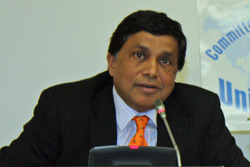 Mr. Damodaran began by explaining the importance of the civil society movement in furthering the work of the United Nations. The MDGs are not just the work of heads of state and UN insiders – the need to teach them has been validated by academics. In the belief that in developed nations “convenience precedes ignorance”, in 2010, 540 institutions of higher learning in 96 countries signed on to the UN’s Academic Impact Initiative.
Mr. Damodaran began by explaining the importance of the civil society movement in furthering the work of the United Nations. The MDGs are not just the work of heads of state and UN insiders – the need to teach them has been validated by academics. In the belief that in developed nations “convenience precedes ignorance”, in 2010, 540 institutions of higher learning in 96 countries signed on to the UN’s Academic Impact Initiative.
As rationale for the Initiative, he quoted from President John F. Kennedy’s Inaugural address of Jan.20, 1961: “The world is very different now. For man holds in his mortal hands the power to abolish all forms of human poverty and all forms of human life…
To those people in the huts and villages of half the globe struggling to break the bonds of mass misery we pledge our best efforts to help them help themselves for whatever period is required…not because we seek their votes, but because it is right…
To that world assembly of sovereign states, the United Nations, our last best hope in an age where the instruments of war have far outpaced the instruments of peace, we renew our pledge of support – to prevent it from becoming merely a forum for invective, to strengthen its shield of the new and the weak, and to enlarge the area in which its writ may run…
Now the trumpet summons us again… to bear the burden of a long, twilight struggle – a struggle against the common enemies of man: tyranny, poverty, disease and war itself.”
The goal of the Academic Impact Initiative is a partnership, to enable faculty and students to better understand the UN and the MDGs, while allowing the UN to infuse its work with their ideas and experiences. Public commitment to UN purposes and goals is a positive step toward campus globalization.
AFTERNOON PANELS
Health MDGs – 4, 5 & 6
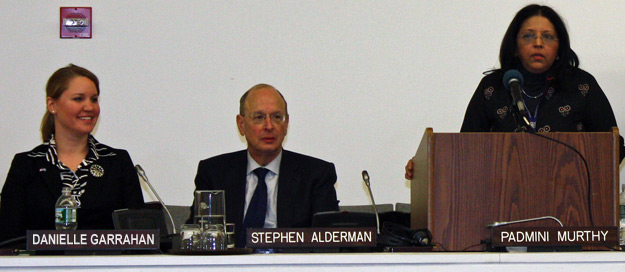 Moderator: Dr. Padmini Murthy, Asst. Professor and Director, Global International Health Program, NY Medical College, Valhalla NY
Moderator: Dr. Padmini Murthy, Asst. Professor and Director, Global International Health Program, NY Medical College, Valhalla NY
Speakers: Danielle Garrahan, Global Partnerships, UN Foundation — www.unfoundation.org
Dr. Stephen J. Alderman – radiation oncologist, co-founder of the Peter C. Alderman Foundation — www.petercaldermanfoundation.org
DR. MURTHY
– introduced the topic by saying that 95% of the world’s diseases are preventable. She quoted an African proverb “A pregnant woman has one foot in the grave,” and told us that maternal death has actually risen in the last decade, going from 891 in 1998 to 1065 in 2008 in Chad for example, due to births at home, and lack of training to repair fistulas. She also mentioned a BBC film, “Dead Moms Don’t Cry”, about childbirth in Malawi.
MS. GARRAHAN
– spoke about The UN Foundation, founded by Ted Turner, which is about building partnerships. She told us about a partnership between the NBA and a UN Foundation project in Africa –”Nothing But Nets”– www.nothingbutnets.net. 90% of deaths from malaria happen in Africa between 10PM and 4AM, affecting one child every 45 seconds.
Resolving the problem costs $10, which includes purchase of an insecticide- sprayed net, delivery and training. A 4 month bus trip to 31 cities to give workshops and support is planned.
She talked about a second project called “Girl Up”, which started in Liberia. She told us that as a rule, women invest 90% of their income in their families compared to 30% for men. Their hope is to engage American girls in support of girls abroad. One such effort involved American students working one day entirely without supplies, to try to understand the challenges facing students in developing countries.
DR. ALDERMAN
-began by telling us that 1 billion people in 50 countries experience violence annually, and 1.8 million are internally displaced. 70% have post-traumatic stress syndrome (PTSD) following war, to such an extent that they can’t leave their beds. The number of people afflicted with neuro-psychiatric disease exceeds that of HIV/AIDS and TB combined. He mentioned in particular Chile, Rwanda, Afghanistan, Liberia, and Uganda, a country that has known nothing but war since 1962.
The Alderman Foundation was created to honor the life of Dr. and Mrs. Alderman’s son Peter, who died in the attack on the World Trade Center on Sept. 11th, 2001. Its mission is to heal the emotional wounds of victims of terrorism and violence by training doctors and establishing trauma treatment centers in post-conflict countries. Funding is very hard to come by for the treatment of mental health, because results are difficult to quantify. But patients with AIDS are unlikely to take their retroviral drugs, or diabetics to stay on an appropriate diet if their mental state is unstable, he told us. In addition PCAF has found a direct correlation between the mental health of mothers and the health of their children.
PCAF now has two clinics in Cambodia. Their clinical model provides group therapy at a cost of $21, 600 per group. They have recently teamed up with Partners in Health to work in Haiti, and give capacity building conferences in Africa for mental health professionals each year. This summer’s conference will be held in Nairobi. Since its inception, PCAF has treated over 100,000 patients.
BEST PRACTICES AWARDS
Coordinators: Dr. Jacqueline Abbott and Dr. Margaret Anzul
Awards were given to the following:
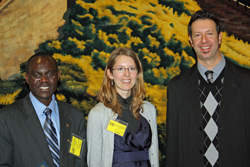
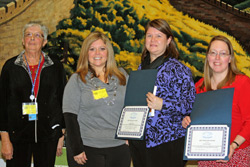
David Angwenyi and Lindsey Makofka of Hopewell Central HS in Pennington, NJ.
Project title: Global Bridge for Better Communities
Focus: Students and adults spent two weeks in Keroka, Kenya, and raised $30,000 for 5000 mosquito nets to prevent the spread of malaria. They have also created a model World Health Organization (WHO) to raise awareness in the school and community about health issues.
Lori Bathurst of the Chestnut Ridge Middle School in Washington Township, NJ.
Project title: Humanities Hope for Change
Focus: To personalize issues of prejudice and genocide, she developed a 7th grade unit on Rwanda, bringing in speaker Ann Halsey, author of Land of a Thousand Hills: My Life in Rwanda; students prepared by reading articles, watching You Tube videos and researching the internet. Using technology, students will be communicating with war afflicted children in the Imbabazi Orphanage — www.imbabazi.org.
Connie Rensink, Kaylyn Hughes, Kim Gideon and Annagrace Small of North
Euless Elementary School, Euless, TX.
Project title: Club We Can
Focus: To help students in grades 3 -6 understand human rights, they designed a model for planning volunteer work; students organized projects based on human rights –a food drive, fund-raising for children in Kenya etc.
Mark Wise, Curriculum Supervisor of West Windsor-Plainsboro Regional School District, NJ and Seamus Dowling and Michael Jackson of Grover Middle School
Project title: Global Race to the Top
Focus: A simulation involving the creation of $50 million development plans to suit the needs of assigned countries, which they then presented for judging. Winning students then skyped with outside experts, including members of the Obama administration, the UN Millennium Campaign and UNDP. A DVD of the project is available by e-mailing mark.wise@ww-p.org
Education MDGs – 2, 3
 Moderator: Dr. Lori Heninger, Director, Inter-Agency Network for Education in Emergencies (INEE )
Moderator: Dr. Lori Heninger, Director, Inter-Agency Network for Education in Emergencies (INEE )
Speakers: Dr. Changu Mannathoko, Sr. Policy Advisor, UNICEF
Rochelle Roca–Hachem, Program Specialist for Culture, UNESCO (the United Nations Educational, Scientific and Cultural Organization)
Julie Ann Salthouse, Chapter Director, Girls Learn International with Nadia Tareen, Student
DR. HENINGER
began by saying that the commitment of schools and teachers opens doors between the global and the local. She observed that girls who marry younger and without education, have less healthy children. She showed an animated video from Vital Voices, documenting the struggles of a Kenyan girl against her cultural traditions, to delay marriage in order to become a teacher. A testament to the human spirit of determination, the Kenyan teacher now has a PhD., and has started her own school.
DR. MANNATHOKO
focused on teacher education. She told us that in the decade ending in 2007, school enrollment in Africa increased from 52% to 74%, especially in Ethiopia. Yet, at the elementary level, 69 million are still out of school, and at the secondary level the number rises to 71 million. Many who complete secondary school are still on the streets due to a lack of available jobs.
There is a shortage of teachers in sub-Saharan Africa and South Asia. Due to budget cuts, there has been a decrease in teacher education institutions, resulting in many teachers who are unqualified; in addition, a number have died of AIDS. UNESCO has a program to work with teachers in Kenya and Uganda to enable them to live HIV positive and become community leaders despite the stigma, and a partnership now exists between teachers’ unions in the US and in Kenya to educate about HIV/AIDS.
Schools lack money to invest in curriculum materials and classrooms, but UNESCO is working to provide distance education for teachers using technology, which can be especially beneficial to people in remote rural areas; they also have a degree program on Human Rights in South Africa.
MS. ROCA-HACHEM
– gave us a brief history of UNESCO, which began with rebuilding schools and preserving cultural heritage sites after World War II, but grew into a center for cross-cultural communication as they began to focus on how peace is constructed in the minds of men.
UNESCO takes a human rights approach to education, and sees cultural diversity, not as a divisive force, but as an asset that leads to cultural cohesion. In an age of globalization, education is the platform for preventing marginalization and the conflict that results from it. They have published a book called “Reaching the Marginalized,” and guidelines on intercultural education, and have focused on textbook revision e.g. how Islamic culture is portrayed in European textbooks, and how the historical realities of World War II play out in Poland and Germany.
August 2010-2011 has been declared the International Year of Youth. The theme is “Dialogue and Mutual Understanding”, and UNESCO encourages the teaching of tolerance in US classrooms. In Lebanon they produced a book exploring the cultural traditions of Christian and Islamic communities. In March, 2011, there will be a report on children and armed conflict, focusing on the role of education in reconciliation.
MS. SALTHOUSE
– spoke about student leadership efforts in conjunction with article 26 of the Universal Declaration on Human Rights and Goal # 8 of the MDGs. Girls Learn International works to engage American students with partner schools in countries where girls have less access to education, and provides for the building of separate bathroom facilities, education of women teachers, and tuition costs for students. American students develop their own advocacy campaigns in schools in 16 states; the organization also works in Abu Dhabi.
MS. TAREEN
– spoke of her “Girls Learn” experiences as a student and projects arising from the Bryn Mawr partnership with Pakistan – scrapbooks, collaborative quilts, jewelry, awareness events such as art exhibits and musicals, to raise funds for teachers’ salaries, supplies and uniforms etc. She believes that this experience has had a strong impact on her own view of the world.
Conclusion
DR. HENINGER concluded by informing us about education in emergencies, including earthquakes, floods, the conflict in Afghanistan, and even hurricane Katrina. “Crises don’t just happen someplace else,” she said. She asked the question, “Are we prolonging life or postponing death?” as the average length of displacement for both refugees and the internally displaced is 17 years. Education that takes place during this time provides a structured lifeline in the midst of chaos, and includes learning about health and sanitation, and avoiding land mines, and addresses psycho-social issues. At a meeting in Dakar, Senegal in 2000, participants agreed to a 4-pronged program: prevention, preparedness, response and recovery. “It’s important to have a vision,” she said. INEE works in 135 countries.
Another focus is on how curriculum can unite or divide people. What language is it in? How can stereotypes be broken down? She encouraged teachers to invite students from other countries to speak, and to make changes from the bottom up. She mentioned a PBS film called “Time for School” and invited teachers to e-mail her for middle school curriculum materials.
CLOSING KEYNOTE
HELEN CLARK
Administrator UNDP; Former Prime Minister of New Zealand
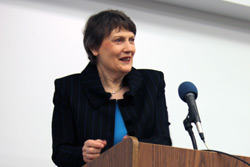 Ms. Clark’s summary struck many of the chords presented by our earlier speakers. She spoke of the impact of natural disasters on the poor who have done nothing to cause them. “Basic social safety nets are a moral obligation,” she said. “If my neighbor is poor, I am too.”
Ms. Clark’s summary struck many of the chords presented by our earlier speakers. She spoke of the impact of natural disasters on the poor who have done nothing to cause them. “Basic social safety nets are a moral obligation,” she said. “If my neighbor is poor, I am too.”
She affirmed the idea that education is transformational, and knowledge is power, and told us that there is a 10% increase in earnings for every year a person attends school, and that children of mothers who can read have a much greater survival rate beyond the age of five. She spoke of success stories like the country of Benin, which, in 1999, had the lowest level of school enrollment, and is now nearing universal primary education. Overall, there has been an 18% increase in enrollment in sub-Saharan Africa. Girl-friendly schools in Egypt provide not only free education, but meals as well, as 1/3 of students suffer from poor nutrition. Teachers have been powerful advocates for quality basic education in Ethiopia, the Philippines and the US. She mentioned “The Girl Effect”, a video connecting girls’ education to all the MDGs.
Yet challenges remain. People with 5 years of education are still only 40% literate. In 2008, $2 billion was spent in the poorest countries, compared with $1.5 trillion on military expenditures. There is a need for speed if we are to reach the 2015 goals, and, in response to the question, “Where do we go from here?” affirmed that international support must continue beyond 2015, with a second millennium challenge.
CHORAL CLOSING
United Nations Singers
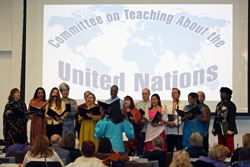 This is a group of people from around the world, who work at UN Headquarters and sing at UN-related events in many languages. They had just begun an initiative to raise money to help advance primary education. They came in native costume, and sang two folk songs, then closed with the very appropriate “Let There Be Peace on Earth, and Let it Begin with Me”, in which the audience was invited to participate. This song may be found in the UN Bookstore, in a picture book that comes with a 12-song CD (see TEACHER RESOURCES section).
This is a group of people from around the world, who work at UN Headquarters and sing at UN-related events in many languages. They had just begun an initiative to raise money to help advance primary education. They came in native costume, and sang two folk songs, then closed with the very appropriate “Let There Be Peace on Earth, and Let it Begin with Me”, in which the audience was invited to participate. This song may be found in the UN Bookstore, in a picture book that comes with a 12-song CD (see TEACHER RESOURCES section).
INFO FAIR EXHIBITORS
The Peter C. Alderman Foundation www.petercaldermanfoundation.org seeks to heal the emotional wounds of victims of terrorism and mass violence by training doctors and establishing trauma treatment systems in post-conflict countries around the globe.
Asia Society/Partnership for Global Learning www.asiasociety.org/education connects state district decision makers, school leaders, teachers, and university faculties. Its purpose is to move international education from the margins to the mainstream by connecting policy and practice to prepare American students to excel in an interconnected world.
Bicycles Against Poverty www.bicyclesagainstpoverty.org encourages community cooperation and to improve accessibility through the use of bicycles for low income families.
Blume’s Distillation www.blumesdistillation.com is a part of IIEA, which develops outreach programs to underscore the benefits associated with the production and use of Bio-alcohol and Ethanol fuels.
Concern Worldwide www.concernusa.org launched Global Concerns Classroom in 2001 to provide free resources and support to educators seeking ways to raise awareness of global issues among youth and to empower them to take action against poverty.
Earth Child Institute www.earthchildinstitute.org is committed to combating climate change, deforestation, and water scarcity through hands-on environment and educational projects with and for children, both in and outside of school.
Fordham University’s Institute of International Humanitarian Affairs www.fordham.edu/iiha trains humanitarian workers through its rigorous academic courses on the graduate and undergraduate levels.
Girls Learn International, Inc. www.girlslearninternational.org pairs American middle and high school-based chapters with Partner Schools in countries where girls have been traditionally denied access to education. The GLI Program gives students the opportunity to explore issues affecting girls in the context of global human rights, promotes cross-cultural understanding and communication.
Global Teaching and Learning Program www.undpi.org The Education Outreach Cluster of the UN Department of Public Information creates and disseminates educational material on the UN and global issues on its agenda to students and teachers at all educational levels to build long-tem support.
Green Contributor www.greencontributor.com promotes educational programs to develop sustainable changes to ensure clean water availability both locally and globally.
Heifer International www.heifer.org works with communities to help end hunger and poverty and to care for the earth, by using gifts of livestock and training in sustainable agriculture worldwide and in the United States. Free educational programs give teachers the resources to educate their students about their world neighbors and to inspire them to help Heifer build a better world.
The Hunger Project www.thp.org is a global, non-profit, strategic organization committed to the sustainable end of world hunger. In Africa, South Asia and Latin America, THP seeks to achieve this goal by empowering people to lead lives of self-reliance by mobilizing village clusters at the grassroots level, empowering women as key agents of change, and forging effective partnerships with local governments.
INEE www.ineesite.org is the open global Inter-Agency Network for Education in Emergencies with over 5000 members in 130 countries, working to ensure the right to safe, quality education for all persons.
Mercy Corps Action Center www.actioncenter.org/newyork seeks to build productive communities around the world through global citizenship education for K-University students. They do this through their international youth connectivity program, Global Citizen Corps partnerships, workshops and video conferences. Workshops, partnerships and teacher training are available.
Office of the Secretary General for Children and Armed Conflict www.un.org/children/conflict was established in 1996 and serves as an independent advocate for protection and well-being of children affected by war. It is a monitoring and reporting mechanism for grave child rights violations.
Nothing But Nets www.nothingbutnets.net is a global grassroots campaign of the UN Foundation to raise awareness and funding to combats malaria.
Project Gaia www.projectgaia.com is a Global Clean Fuel Initiative seeking to replace polluting fuels with renewable alcohol fuels.
PPAF www.ppafoundation.org The Public-Private Alliance Foundation is associated with the UN and seeks to reduce poverty by networking with business, governments, academia, and non-profits.
Transdiaspora Network, Inc. www.transdiasporanetwork.org is a non-profit organization dedicated to raising awareness about HIV prevention in innovative ways, such as dance, storytelling and photography. Their mission is to communicate with at-risk youth regarding HIV/AIDS.
The United Nations Development Programme www.undp.org is the UN’s global development network, advocating for change and connecting countries with knowledge and resources to improve their lives. They are on the ground in 172 countries, working with governments and people to bring about their own solutions to global and national development challenges with the aid of the staff of UNDP.
The United Nations Foundation www.unfoundation.org is a public charity, which builds and implements public/private partnerships to address the world’s most pressing problems and work to broaden support for the UN through advocacy and public outreach. The campaigns they conduct reduce child mortality, empower women and girls, create a new energy future, secure peace and human rights, and promote health improvements through technology.
US Fund for UNICEF www.unicefusa.org provides children with health care, clean water, nutrition, education, and emergency relief. The US Fund supports this work through fundraising, advocacy, and education in the United States.
